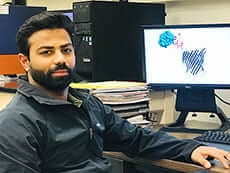Avi Thakar ’19
Turning Student Research into Reality
 Avinash “Avi” Thakur, a Ph.D. candidate in the Department of Physics in the College of Arts and Sciences (A&S), recently made headlines with his role in the development of a novel class of nanomaterials that could possibly improve cancer detection.
Avinash “Avi” Thakur, a Ph.D. candidate in the Department of Physics in the College of Arts and Sciences (A&S), recently made headlines with his role in the development of a novel class of nanomaterials that could possibly improve cancer detection.
The announcement—courtesy of a paper he co-authored with physics professor Liviu Movileanu in Nature Biotechnology (Springer Nature, 2018)—probed the real-time measurement of protein interactions at the single molecular level, using a genetically modified hole, or nanopore. The online version quickly became the journal’s top-ranked article, marking the culmination of a six-year student-mentor relationship.
“This paper is the result of an amazing journey with many obstacles and detours,” says Movileanu citing Thakur’s drive and persistence. “Avi is an inspiration to other graduate students, as well as talented undergraduates pursuing careers in fundamental science and medical biotechnology.”
The Indian-born student is unmoved by the praise, saying A&S—and Movileanu’s lab, specifically—affords him opportunities to design his own projects and experiments.
“I came here because I wanted to grow as an independent researcher,” says Thakur, who expects to earn a Ph.D. in May. “By working with other departments on campus—including biology, chemistry, and biomedical and biochemical engineering—I have helped design something that could potentially transform into a technology. This work may benefit drug discovery [in medicine, biotechnology and pharmacology] and protein-based diagnostics.”
A&S recently caught up with Thakur—whose expertise combines protein engineering, design and application—to discuss his time in A&S.
Your background includes biochemistry and biotechnology. How did it prepare you for Syracuse University?
With my training in biotechnology, I learned about next-generation applications of protein engineering in various fields, including diagnostics and therapeutics. With biochemistry, I learned the tools and techniques that would help me develop, design and validate new protein engineering approaches.
Such as nanobiosensors?
Yes. I design and develop barrel-like sensors that are 100,000 times thinner than a human hair. These sensors detect proteins and transduce [convert] that detection into an electrical current as an output.
We think our sensors have a role in existing flow cells and microfluidic devices, enabling high-throughput drug screening against protein targets of interest.
So that I understand correctly—you create a hole in a biological membrane, through which you shoot an electric current. When a protein goes in or near the hole, the current’s intensity changes, enabling you to identify the protein’s properties and identity, right?
Indeed. Our sensor is capable of detecting and quantifying proteins in a clinical sample-like condition, such as blood serum, with great accuracy.
PPIs [protein-protein interactions] occur everywhere in the body, but are hard to detect with existing methods because they last only a millisecond. Our real-time techniques may help diagnose disease in which a protein is a biomarker [a measurable indicator of a disease state].
Liviu must be an inspiring mentor.
I like his positive approach to problem solving. He has taught me not to get too disappointed with failure or setbacks. The physics department also is pretty chill. The people are friendly.
What are your short-term plans?
I will defend my thesis in February. Afterward, I want to do postdoctoral training to enhance my skills as an independent research scientist. Post-training, I would like to be a research group leader in industry or academia.
What’s the best piece of advice you’ve ever gotten?
Believe in yourself, your friends, your family and your work. When you do that, great things happen.
